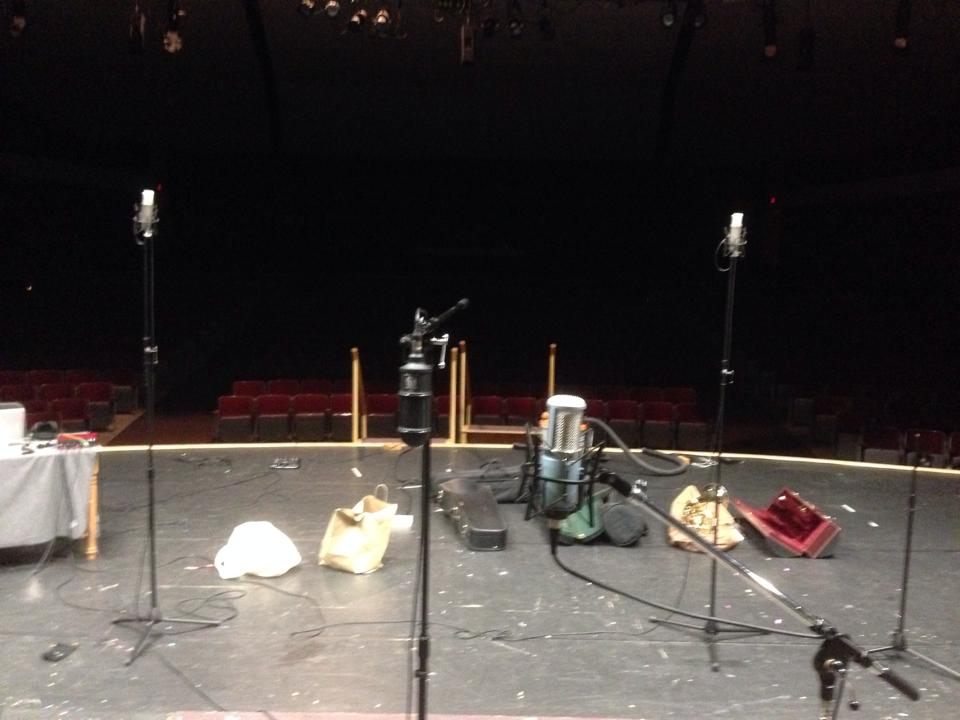
I’m not always the one behind the mics, such as this (admittedly shaky) shot from last summer’s sampling bonanza.
If you’ve seen trailers for virtual instruments with real footage of the musicians performing, you probably see a 10-second or less clip of some cool note or just some silent close-ups while some dramatic music created using the plugin months after the original session.
In reality, sampling sessions are long, slow, borderline Zen marathons of endurance, especially when alone, as is often the case in such Guerrilla-style sampling sessions as those I often run. In which case, I either see something like the above or like the image below-

Any pianist will tell you sitting at a piano for two hours is a long time… sitting at a piano for two hours playing one note at a time waiting for each note to decay is an eternity.
The way sampling alone typically ends up is, you spend the first 15-30 minutes setting up and calibrating the microphones to your taste (meaning every time you want to make an adjustment, you have to put your instrument down, go run over to the interface, turn some knobs, and then run back). Then you come up with your plan of attack. This plan relies on four factors, regardless of if you are the one playing or if someone else is playing for you:
- Scale: How will you approach the instrument? Diatonically? Chromatically? How much time do you have? See this blog post for some ideas and reflections on the matter.
- Articulations: What are the common articulations? Can you play them? How many velocity layers can you divide it in? Do you need round-robin/multisampling?
- Range: Can you play the outer range of the instrument? Do you need to adjust your plan to help your endurance?
- Mics: How are you going to mic your instrument? What tone do you want to bring out? How does the instrument sound in tests?
These four factors all lead into the overall feel and functionality of the final product. Some people like planning these meticulously months ahead of time, others such as myself do some basic planning and let the rest fall into place in case there are issues or other concerns (which there always seem to be). You must always plan your time and have a preliminary plan for mics when you go into a session. Range and exact Scale can be determined on the spot, as can some final mic placement changes to adapt to room environment and instrument behavior/design.
After all that planning comes the first note and the marathon begins. You enter a game of mental and physical endurance- the normal challenges of performing augmented by the demands of a careful performance (no giant flubs, please), not to mention monitoring the progress and success of your session (RR? Note? Velocity Layer?). The first few notes are often reluctant and feel unnatural. You can see this on the faces and in the nervous laughs of many musicians who play for you in sessions. But, as time goes on, after about 10-15 minutes, a pattern evolves. A systematic, organized process takes over.
As human beings, we love to be able to understand our world via classification and organization. We develop patterns to create a sense of continuity and comprehension of our surroundings. While sampling, this natural order asserts itself and the repetition, like a mantra, becomes second nature. You begin to forget that you are playing an instrument. You begin to forget that you are using your fingers, lungs, eyes, and ears to carefully perform and shape each note and slip into a trancelike state, feeling and straining to hear each note dissolve into the beautiful nothingness of the dark hall that lies before you. Sometimes you jolt to your senses realizing you just held a piano key down for a minute and a half, listening to the almost imaginary whisperings of the very last resonances in the strings.
In many ways, sampling is similar to piano tuning tuning. It encourages a deep listening that most musicians don’t encounter in everyday playing. You become strikingly aware of the shape and the breadth of each note that you produce, and the subtle beating of strings and harmonics and all else. Weird overtones that you never noticed before play sharply in your ears. It’s a fascinating state, and has opened my ears in new ways while performing and composing (not to mention fueled an interest in minimalist free improvisation).
Then you find yourself at the end with nothing more to play. You have finished your work, like a marathon runner a race, and now it is time to rinse, wash, and repeat with the next instrument.


